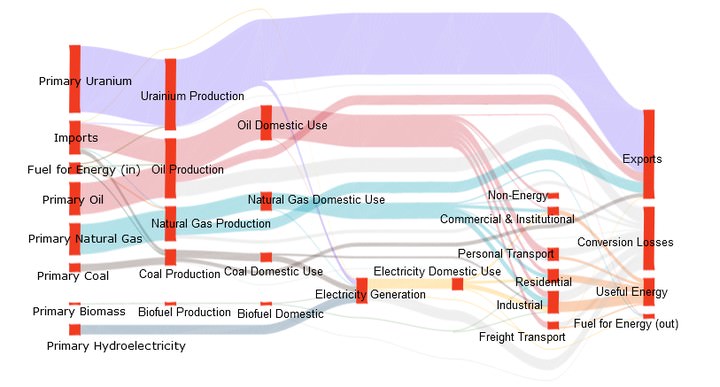Dynamic Globe Visualization
Haleh Aslemasoom, Faramarz Samavati, John Brosz, and David Layzell
 Canadian energy system (1978) visualized with a Sankey diagram. |
Energy systems are under pressure to transform to address concerns about climate change. The modeling and visualization of energy systems can play an important role in communicating the costs, benefits and trade-offs of energy systems choices.
In this project we built a visualization tool for exploring time-varying, multi-attribute and spatial properties of an energy system. The tool integrates several visualization techniques to facilitate exploration of the energy system. These techniques include Sankey diagram representation to show energy flow, 3D interaction with Sankey diagrams for expanding viewable data attributes such as emissions and an interactive map integrated with flow diagrams for simultaneous exploration of spatial and abstract information. We also perform level of detail exploration on flow diagrams and use smooth animation across the visualizations to represent time-varying data.
 Canadian energy system visualized with Sankey diagram at two different levels of detail. |
Sankey diagrams are a commonly used to show energy flows from resources, through commodities to services. These diagrams provide a top-down perspective on energy systems and make it possible to identify major features, inconsistencies or questionable aspects of the data that require closer and critical analysis. A Sankey diagram arranges nodes in layers based on the incoming and outgoing edges.
 A flow map used to visualize energy transfer across Canada. |
Video: https://vimeo.com/98084399
Paper: Interactive Visualization of Energy System. Haleh Aslemasoom, Faramarz Samavati, John Brosz, and David Layzell. 2014 International Conference on Cyberworlds, pp. 229-236 (2014). DOI: 10.1109/CW.2014.39. PDF
Paper: EnergyViz: an interactive system for visualization of energy systems. Haleh Aslemasoom, Faramarz Samavati, John Brosz, and David Layzell. The Visual Computer, vol 32, pp. 403-413 (2016). DOI: 10.1007/s00371-015-1186-8. PDF